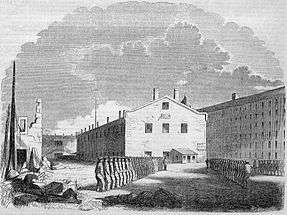Auburn system

The Auburn system (also known as the New York System) is a penal method of the 19th century in which persons worked during the day in groups and were kept in solitary confinement at night, with enforced silence at all times. The silent system evolved during the 1820s at Auburn Prison in Auburn, New York, as an alternative to and modification of the Pennsylvania system of solitary confinement, which it gradually replaced in the United States. Whigs favored this system because it promised to rehabilitate criminals by teaching them personal discipline and respect for work, property, and other people.
Among notable elements of the Auburn system were striped uniforms, lockstep, and silence.
Prison life

During the 19th century, prisoners had no rights or any opportunity to live semi-comfortably. The Auburn system established several characteristics that were unique to the world of disciplinary conditions. Silence was the biggest factor in the line of rules the prisoners had to follow. John D. Cray, a deputy warden at the Auburn Prison, demanded that the prisoners be completely silent to take away the prisoners' “sense of self”. When the “sense of self” was taken away, many convicts became compliant and obedient to the warden's wishes.
The second characteristic of the Auburn system that was important to prison life was the community activities. During regimented times during the day, the prisoners would have different tasks to perform every day. Some of these tasks included making “nails, barrels, clothing, shoes and boots, carpets, buttons, carpenters' tools, steam engines and boilers, combs, harnesses, furniture, brooms, clocks, buckets and pails, saddle trees...”.
During the 1840s, the prison began to make production in the silk business by bringing in silk worms and trees. The Auburn correctional facility was the first prison to gain money as a profit for the labor of the prisoners. The prison also gained many sight-seers during the 19th century. These visits by strangers made life even more unbearable because of the constant flow of free people.
Lockstep and clothing
Elam Lynds, in association with John D. Cray, developed a revolutionary system of transporting the convicts around the prison complex. The prisoners marched in unison and had to lock their arms to the convict in front of them. The prisoners had to look to one side and were not allowed to look at the guards or the other inmates. The clothing of the Auburn state prison was very simple: a grayish material with horizontal stripes.
Punishment
In 1821 a new principal keeper, Elam Lynds, was appointed to run the prison. He believed absolutely in the disciplinary power of the lash and used flogging to punish even minor infractions. In 1839 a prisoner died from neglect and over-flogging. The committee of Auburn and other staff members of the Auburn Theological Seminary petitioned to bring the issue of the punishments to the State government. “The law stated that six blows on the naked back with the 'cat' or six-stranded whip was the most punishment that could be assigned for any one offense.”
In 1846 another meeting was congregated to abolish the use of whips as punishment. The flagellation could only be used for riots or in severe cases. When whippings were prohibited, guards and keepers searched for new and inventive ways to punish the disorderly. “The shower bath consisted of a barrel about 4½ feet high with a discharge tube at the bottom. The prisoner was stripped naked, bound hand and foot, with a wooden collar around his neck to prevent him moving his head. The barrel, with the inmate inside, was placed directly under an outlet pipe, where water, sometimes iced, would pour down.” Another form of punishment that was allowed was “the yoke”. The yoke used iron bars around the neck and arms of the prisoners.
Women and the prison
In the early days of the prison, women inmates were held in the windowless attic atop of the high security prison. They shared a single room and slept in the same area where they worked, primarily at "picking wool, knitting, and spooling." In 1838 all women prisoners were transferred to the then-new female wing at Sing Sing, but in 1892 the women returned to a new building added to the Auburn prison. The Auburn Women's Prison remained in operation until 1933, when a new maximum-security wing for female inmates opened at Bedford Hills.